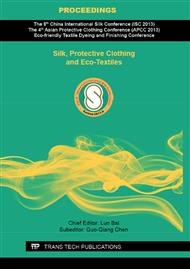p.3
p.9
p.15
p.21
p.25
p.36
p.39
p.43
Preparation and Characterization of Biomimetic Mesoporous Bioactive Glass-Silk Fibroin Composite Scaffold for Bone Tissue Engineering
Abstract:
Three-dimensional (3D) mesoporous bioactive glass (MBG) scaffolds were obtained by using the demineralized bone matrix (DBM) and P123 as co-templates through a dip-coating method followed by evaporation induced self-assembly (EISA) process. 3D mesoporous bioactive glass-silk fibroin (MBG/SF) composite scaffolds were prepared by immersing MBG scaffolds into SF solutions with different concentration. Transmission electron microscopy (TEM), field mission scanning electron microscope (FESEM), fourier transform infrared spectroscopy (FT-IR) and wide angle X-ray diffraction (WA-XRD) were used to analyze the inner pore structures, pore sizes, morphologies and composition of the scaffolds. The in vitro bioactivity of the scaffolds was evaluated by soaking in simulated body fluid (SBF). The results showed that the MBG and MBG/SF composite scaffolds with the interconnected macroporous network and mesoporous walls could be obtained by this method. In addition, both the MBG scaffolds and the MBG/SF composite scaffolds have excellent apatite-forming bioactivity. Therefore, this method provides a simple way to prepare scaffolds for bone tissue engineering.
Info:
Periodical:
Pages:
9-14
Citation:
Online since:
September 2013
Authors:
Price:
Сopyright:
© 2013 Trans Tech Publications Ltd. All Rights Reserved
Share:
Citation:


